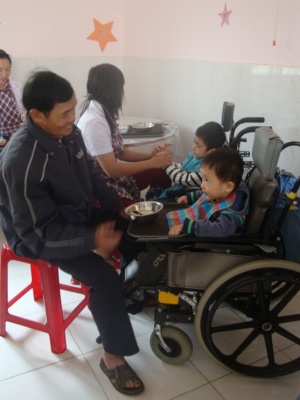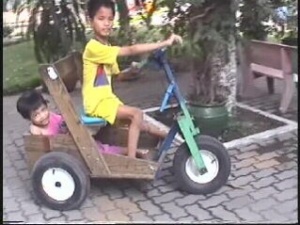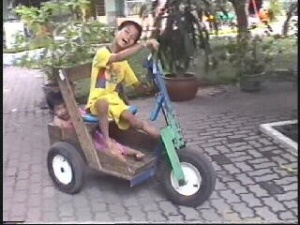ICF and RPS within Cerebral Palsy
Introduction [edit | edit source]
This week we will look at the International Classification of Functioning, Disability and Health framework (ICF) and the Rehabilitation Problem Solving (RPS) form based on the ICF with children who have Cerebral palsy.
Objectives[edit | edit source]
To undrestand the concept of the International Classification of Functioning, Disability and Health in the field of children with cerebral palsy
To understand the importance of using this framework for working with children with cerebral palsy
Be apply to the ICF and RPS in working with children with cerebral palsy and their family
International Classification of Functioning, Disability and Health Framework (ICF)[edit | edit source]
The International Classification of Functioning, Disability and Health, known more commonly as the ICF, is a classification of health and health-related domains. These domains are classified from body, individual and societal perspectives by means of two lists: a list of body functions and structure, and a list of domains of activity and participation. Since an individual’s functioning and disability occurs in a context, the ICF also includes a list of personal and environmental factors. The ICF is WHO's framework for measuring health and disability at both individual and population levels.
ICF has two parts and each part has two components:
Part 1 - Functioning and Disability
- Body functions and body structures
- Activities and Participation
Part 2 - Contextual Factors
- Environmental factors
- Personal factors.
Terminology used in the ICF: [edit | edit source]
- Impairments are problems in body function or structure such as a significant deviation or loss e.g. paralysed leg
- Activity limitations are difficulties an individual may have in executing activities e.g. walking
- Participation restrictions are problems an individual may experience in involvement in life situations.e.g. joining school
- Personal factors are: gender, ethnic background, age, other health conditions, fitness, education, social background, coping styles, etc
- Environmental factors are: products and technology, natural environment and human made changes to environment ,support and relationships, attitudes, values and beliefs, services, systems and policies
ICF in (Community Based) Rehabilitation[edit | edit source]
Using ICF provides a (scientific) basis for understanding health and health-related states. It supports looking at and analysing other factors which influence how people with a disability function and participate in their society/community. The ICF establishes a common language around the world, also within the Community Based Rehabilitation (CBR) context. The ICF also enables people to look beyond impairments and activity limitations such as; social, environmental, personal and cultural issues. Internationally the use of the ICF in rehabilitation services is becoming more and more popular.
ICF and Childre with Disabilities[edit | edit source]
When working with children with CP and their families, one tasks is to relate how the therapeutic activities are connected to the desired outcomes. Traditionally therapy was impairment-based so this approach to treatment was primarily based around addressing the problems of body function and structure, which were thought to underlie the functional limitations of the “disability.” Leading to an assumption that “treatment” will produce functional results, and also perhaps an unspoken belief that more therapy will produce better results. The ICF model provides an opportunity from the outset to talk with parents (and older children) about a different set of primary goals that address function (activity) and social engagement (participation). Using this model will improve results of interventions.
Here is an example:
A child with CP who has problems with eating and speaking because of motor control within the face and mouth area may benefit from assessment and intervention focused on motor impairments that make feeding or speech challenging. At the same time, addressing the activity of eating and the child’s participation in family mealtimes, as well as alternative communication strategies, if necessary, ensures that all components of the child’s functioning and health are addressed at the levels of body structure and function, activity, and participation.
People / parents are much more likely to work on things that are important to them than to work on exercises others think are important. How to make eating easier in practice and how to communicate is more important than doing exercises to improve (hopefully) mouth muscle
control. Advice on how to use eating time and how to communicate and stimulate the child to communicate (during activities of daily living)
will give much more practice in using the muscles in the mouth area compared with doing exercises everyday for 20 minutes (which will be done maybe only once a week).
Another example:
A child with CP may be able to walk when there are no physical barriers on a smooth terrain.
When recognizing the importance of the role of the family, supporting of the family is esential. The family has to be involved in setting functional goals in what to achieve. In doing so the family can help to achieve greater functional achievements with less effort compared to traditional impairment based therapy.
This child is mobile with this tricycle, but not when walking.
The house, community and school environment may not be barrier-free and assistive devices can be necessary for this child to participate in
school and community activities. The impairment (balance, muscle control and strength) may not be addressed directly, but probably the net benefit for the child may be considerable improved in function because of active participation, and it is likely that there will be improvements in the underlying impairments as well.
Try to analyse yourself: what impairments are improving if this child is biking around?
Rehabilitation Problem Solving (RPS) - Use of an ICF based form[edit | edit source]
The Rehabilitation Problem Solving (RPS) format is based on the concept of the ICF and internationally being more and
more used in the field of rehabilitation. This RPS form provides also room to write down the opinion of the parent and/or the child about the abilities and disabilities. The space for input by the client is based on the understanding that involvement in the whole assessment and
planning is important in order to be able to make interventions meaningful and successful.
Case study and use of RPS:
Girl 6 years old, with (athethoid) cerebral palsy
This girls lives with her parents and grandparents. All love her and are taking good care of her. She is dependent in all activities of daily living (ADL). She can sit for a few moments without support, but not stand or walk. She can not eat, bath, dress by herself. She stays as home, does not go to school/kindergarten/nursery. She understands everything, speaks some words but not clearly. Points to make clear what she wants.
Focus is on physical rehabilitation because the parents think she needs to be able to walk before going to school.
Assignment
If this girl would be living in your country/province:
- What would be: her impairments, her activity limitations and participation restrictions?
- How do personal factors and the environmental factors influence the opportunities of this child to participate?
- Divide these factors in barriers and facilitators.










